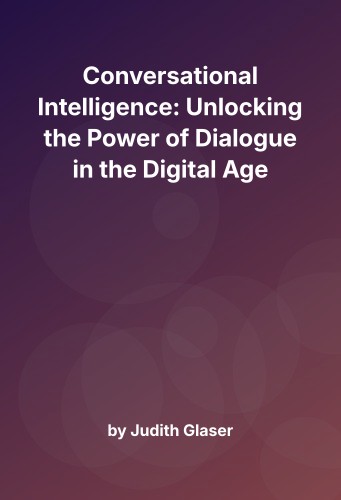Conversational Intelligence: Unlocking the Power of Dialogue in the Digital Age
Introduction: The Art and Science of Conversation
In “Conversational Intelligence,” Judith Glaser delves into the transformative power of effective communication within professional environments. The book serves as a guide to understanding how conversations can shape reality, build trust, and foster innovation in the workplace. Glaser emphasizes that conversation is not merely a tool for exchanging information but a dynamic process that can unlock human potential and drive organizational success.
The Neuroscience of Conversations: Building Trust and Creating Connection
At the heart of Glaser’s exploration is the neuroscience underpinning human interactions. She explains how conversations can either trigger the brain’s threat response or stimulate the production of oxytocin, the ‘trust hormone.’ This insight is crucial for leaders aiming to cultivate a culture of trust. By fostering open, transparent dialogue, leaders can create environments where employees feel safe to express ideas and take risks. This section parallels Daniel Goleman’s work on emotional intelligence, emphasizing the importance of self-awareness and empathy in leadership.
To illustrate, consider a team meeting where a leader encourages open discussion about project challenges. By acknowledging concerns and showing empathy, the leader reduces stress and creates an atmosphere of trust, enabling team members to contribute more freely.
From Transactional to Transformational: Shifting Conversational Dynamics
Glaser introduces the concept of shifting from transactional to transformational conversations. Transactional interactions focus on exchanging information, while transformational dialogues aim to create shared meaning and drive change. This approach is akin to Peter Senge’s learning organizations, where dialogue is a tool for collective learning and innovation. By adopting a transformational mindset, professionals can break down silos and encourage cross-functional collaboration, essential in today’s digital workplace.
For example, in a corporate strategy session, a transactional conversation might focus solely on quarterly goals. In contrast, a transformational dialogue would explore how those goals align with the company’s long-term vision, inviting input from various departments to foster innovation.
The Conversational Dashboard: A Framework for Effective Dialogue
A key framework presented by Glaser is the Conversational Dashboard, a tool for assessing and enhancing the quality of conversations. The dashboard helps professionals identify the level of trust and engagement in interactions, providing a roadmap for moving from low-trust, low-engagement conversations to high-trust, high-engagement ones. This model aligns with agile principles, where continuous feedback and adaptation are crucial for success. By using the Conversational Dashboard, teams can ensure that their dialogues are aligned with organizational goals and values.
The Conversational Dashboard consists of several critical components:
- Trust Meter: Assesses the level of trust present in a conversation. High trust leads to more open and honest exchanges.
- Engagement Gauge: Measures the degree of engagement from participants, indicating their investment in the dialogue.
- Alignment Indicator: Evaluates whether the conversation aligns with the team’s or organization’s goals.
For instance, a team might use the dashboard to analyze a recent brainstorming meeting, identifying areas where trust could be improved to enhance creative input.
Conversational Agility: Navigating Change with Flexibility and Resilience
In the context of rapid digital transformation, conversational agility becomes a critical skill. Glaser argues that the ability to adapt communication styles to different contexts and audiences is essential for navigating change effectively. This concept resonates with the agile manifesto, which prioritizes individuals and interactions over processes and tools. By fostering conversational agility, leaders can build resilient teams capable of thriving in uncertain environments.
For example, during a merger, leaders must communicate effectively with employees from both companies, addressing concerns and fostering a unified culture.
Creating a Culture of Innovation: Harnessing the Collective Intelligence
Glaser emphasizes the role of conversation in fostering a culture of innovation. By encouraging diverse perspectives and open dialogue, organizations can harness the collective intelligence of their workforce. This idea is reminiscent of James Surowiecki’s “The Wisdom of Crowds,” which highlights the power of collective problem-solving. In a digital age where collaboration tools and platforms are ubiquitous, the ability to facilitate meaningful conversations is more important than ever for driving innovation.
Consider a tech company that hosts regular innovation workshops where employees from all levels can pitch ideas. This open dialogue encourages creativity and leverages the diverse skills of the entire workforce.
Conversational Intelligence in the Digital Workplace: Embracing Technology
The book also explores the intersection of conversational intelligence and technology. Glaser discusses how digital tools can enhance or hinder communication, depending on how they are used. She advocates for leveraging technology to augment human interaction rather than replace it. This perspective aligns with the current discourse on AI and automation, where the focus is on augmenting human capabilities. By integrating conversational intelligence with digital tools, organizations can create more inclusive and effective communication channels.
For example, virtual collaboration platforms enable remote teams to maintain open lines of communication, ensuring that geographical barriers do not impede collaboration.
Final Reflection: The Future of Conversations in Business
As organizations continue to evolve in response to technological advancements and global challenges, the principles of conversational intelligence offer a roadmap for success. By prioritizing trust, transparency, and transformation in their dialogues, leaders can create environments where innovation and collaboration flourish. Glaser’s insights provide a compelling case for rethinking the role of conversation in business, positioning it as a key driver of organizational transformation and success.
In summary, “Conversational Intelligence” offers a comprehensive framework for understanding and enhancing the power of dialogue in the professional sphere. By integrating neuroscience, strategic frameworks, and modern parallels, Glaser provides a valuable resource for leaders seeking to navigate the complexities of the digital age with agility and insight. The book’s principles can be applied across domains such as leadership, organizational change, and strategic planning, making it an indispensable guide for anyone looking to harness the full potential of conversation in creating meaningful and lasting impact.

